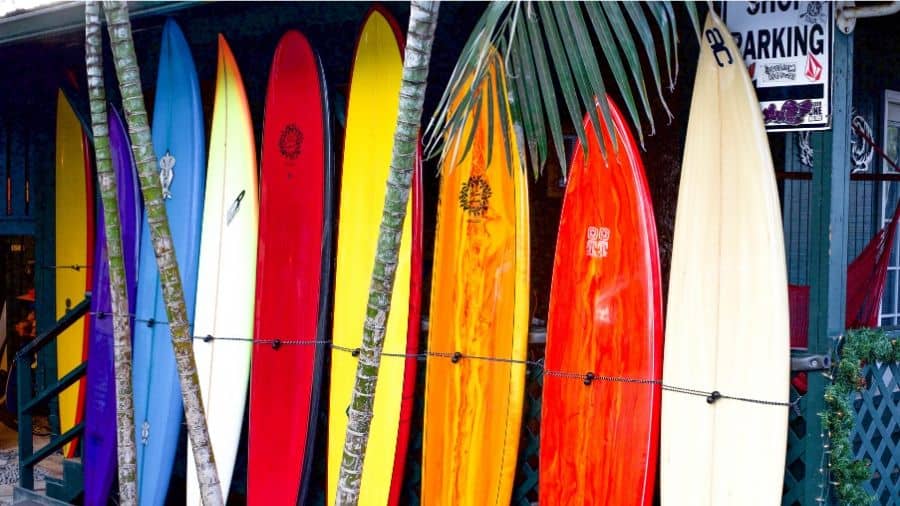
Buying a new surfboard and expanding your quiver is almost as fun as surfing itself – and to some it’s the main draw of the sport! Your new board might have just put you back upwards of a G or you may have just found a dumpster gem, either way, how long should you expect these things to last? Even if used properly, it’s inevitable they will be exposed to sun and salt; not always the friendliest combo.
The average surfer who surfs anywhere between a few times a month and several days each week should be able to make a surfboard last for years with proper care and storage. Your aggressive high-performance shortboarder, on the other hand, will probably get a new board every 6 months to a year. There are many factors that will affect the lifespan of your board, from what type of board material it is to your personal surfing style and how often you surf.
So what else contributes to a board’s life span? There are things you can do to ensure your boards have long comfortable lives frolicking through line ups, throwing buckets, and sneaking into tubes. There’s also lots you can do to give a board a quick painful death.
Table of Contents
Factors that Affect How Long a Surfboard Will Last
Water: Ironically, this might be the number one surfboard killer. Yes, your board is meant to go in the water but the water is not meant to go in your board!
Too many times I notice a little ding on my board and instead of properly repairing it, I just slap some duct tape on it, or even worse, do nothing. This is terrible. The majority of modern surfboards are made from foam covered in fiberglass or epoxy.
If that shell breaks or has a wee crack, the foam will start sucking up water like a sponge. Eventually, if your board sucks up enough water, it will become waterlogged. This is not fun. Your board will be heavy and sluggish and just not feel like it has the paddle speed or wave catching ability that it once did. Also, saltwater is corrosive and can weaken the fiberglass over time.
Sun: Well, sun and heat. Heat causes things to expand. So a board left in the hot sun or inside a hot car is not good. This will cause the foam inside the board to expand. The surface bubbles and separates from the fiberglass. No bueno.
A bubbly lumpy board just doesn’t feel good underfoot, and if it bubbles on the bottom it will affect how it cuts through the water and performs. Also, the sun turns the foam core yellow; not a good look. We all want that crispy, off-the-factory-floor look that just makes you feel like shredding.
Storage: This directly relates to the sun and the heat. Yes, it’s easy to leave your boards in your car and be ready to go at a moment’s notice, but if you live somewhere hot like sunny California or many surfy zones around the world, this will affect the life span of your board.
Leaving your board outside is another easy option. Not having to drag wet and sandy boards into your house is very appealing, and even more so, not having to make space for these things is attractive. But again, this has consequences because the sun and the elements ruin boards.
Type of board: Epoxy v. fiberglass. This could be a whole book on its own. It is a personal preference and it comes down to the way the boards ride. But as for longevity, epoxy is stronger and can take more punishment. That’s why many beginner boards are made with epoxy.
Stupidity: Using your head and being conscious of your board’s location and what’s going on around it can add years to its life. Should you just set your board down anywhere in the parking lot? No. Homie doesn’t know where your board is and he’s about to back over it.
Two flimsy bungee cords should be good enough for the roof of my car? Wrong. You just lost a board on the 405 and caused a 10 car pile up. Yes, those things are rare but they do happen.
More commonly, just be careful where you are leaning or setting your board, especially if it’s windy. They can easily fall over, which causes dings. And last but not least in the stupidity section: BE SMART IN THE WATER. Know where rocks are, use a leash if you’re a beginner, and make sure you’re not snaking anyone before you drop in. All these things will prevent stupid pointless dings and worse.
Surf style: The way you surf and what you surf will affect board longevity. Generally, someone super aggressively riding a high-performance shortboard is going to replace boards more often than your average longboarder.
How to Make your Surfboard Last Longer
There are a few easy things you can do to get extra months or even years out of your boards. Start by storing your boards inside. There are many different rack options for storage. Even if you don’t have a garage or shed, your boards will 100% make your home look cooler.
Having a board bag is a big help. A 5-10 mm padded bag will add extra protection when taking it in and out of the car or during general transport saving you from little and big dings while transporting and storing your board. Some bags are reflective as well. The reflective material directs the heat away from your board keeping it cool and preventing bubbling.
Fix your dings boys and girls. Just do it. Always have a fiberglass or epoxy ding repair kit on hand for the little dings and don’t be too lazy to visit the shop to get the bigger ones repaired. Yes, you might miss a sesh or two while repairing your board, but it will save your board from becoming a soggy mess which cannot be repaired.
Rinse your board with freshwater after a surf. Like I said above, saltwater can weaken the fiberglass. So, giving your board a good rinse with the hose when you get home or at the beach showers if that’s an option is always a good idea.
Just be careful getting in and out of the water. That’s normally where you’ll encounter rocks and other obstacles depending on the break. If it’s a shallow reef break you can flip your board upside down and walk it out until the water’s deep enough so that your fins don’t touch bottom.
When to Replace Your Surfboard
There are some pretty obvious times to replace your board and some not so obvious ones as well.
If you’ve just snapped your board on a macking shore break then I’d say with some certainty it’s time for a new board. Thin small thrusters will eventually get pressure dings from your front foot. Your board will start to feel sluggish because the pressure indentations will allow unintended flexibility. At this time you probably should be looking for or considering a new board.
If you’ve been riding the same board for a while – maybe a bigger one that you learned on and you want to step it up and try something new then it’s time for a new board.
This isn’t necessarily a replacement, but there comes a time to take off the training wheels and start branching out and trying different surfboards besides the “fun board” on which you may have learned. Even if your beginner days were centuries ago it’s always good to get that weird little fish or ancient log to keep things fresh and fun.
